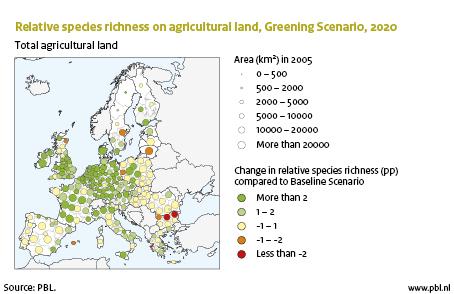Greening the Common Agricultural Policy: impacts on farmland biodiversity on an EU scale
‘Greening’ the EU Common Agricultural Policy (CAP), as proposed by the EC, will slow down the decline in farmland biodiversity, most notably in intensive farming areas. Extensively farmed areas are better served by policies preserving their rich biodiversity. Regional variation in policies tailored to reflect local conditions could, therefore, result in a better outcome.
Impact on biodiversity of greening of the Common Agricultural Policy
In ‘The CAP towards 2020’ (November, 2010) and the ‘EU biodiversity strategy to 2020’ (May, 2011) the European Commission has proposed a generic greening of the EU farm income support. To predict the impacts of these proposals, PBL researchers have used model calculations which assumed extra budget for agri-environmental measures and greening payments for permanent grassland and ecological set-aside of an assumed 5% of the arable land. The results show 3% more farmland species richness in 2020, compared with a baseline scenario. Impacts would be most pronounced in areas of intensive farming, which are presently poor in biodiversity. This 3% is substantial, compared with predicted decline of e.g. the farmland bird index over the 2014-2020 period. However, it will not fully halt the loss of farmland biodiversity.

Impact on production and income
As a trade-off, biodiversity gains would involve a loss in agricultural production, ranging from 2% for grass to 4% for cereal production. This can decrease EU self-sufficiency for food supply. Policy design could alleviate this trade-off by allowing farmers to use the least-producing fields and field edges for greening measures. The average farm income for the EU as a whole would not suffer from yield losses, as these losses are more than counteracted by producer price increases. However, there are considerable income shifts from intensively to extensively farmed regions. In the current CAP, income support is linked to historical production, which favours intensively farmed regions, whereas greening the CAP will link payments more with extensive farming practices.
Optimizing effectiveness with tailor made policies
The variety in farm structures, income, farming intensity and species richness, as well as the divergent impacts of policy changes between EU regions, suggest that regionally differentiated policies may be more efficient than a one-size-fits-all approach. Effectiveness for biodiversity could be improved by stimulating farmers to design ecological set-aside areas in such a way that a regional ‘green infrastructure’ would be created, facilitating the spread of source populations in farmed areas.
Authors
Specifications
- Publication title
- Greening the Common Agricultural Policy: impacts on farmland biodiversity on an EU scale
- Publication date
- 18 August 2011
- Publication type
- Publication
- Publication language
- English
- Product number
- 414